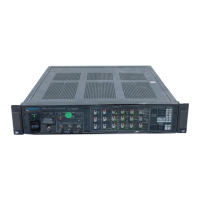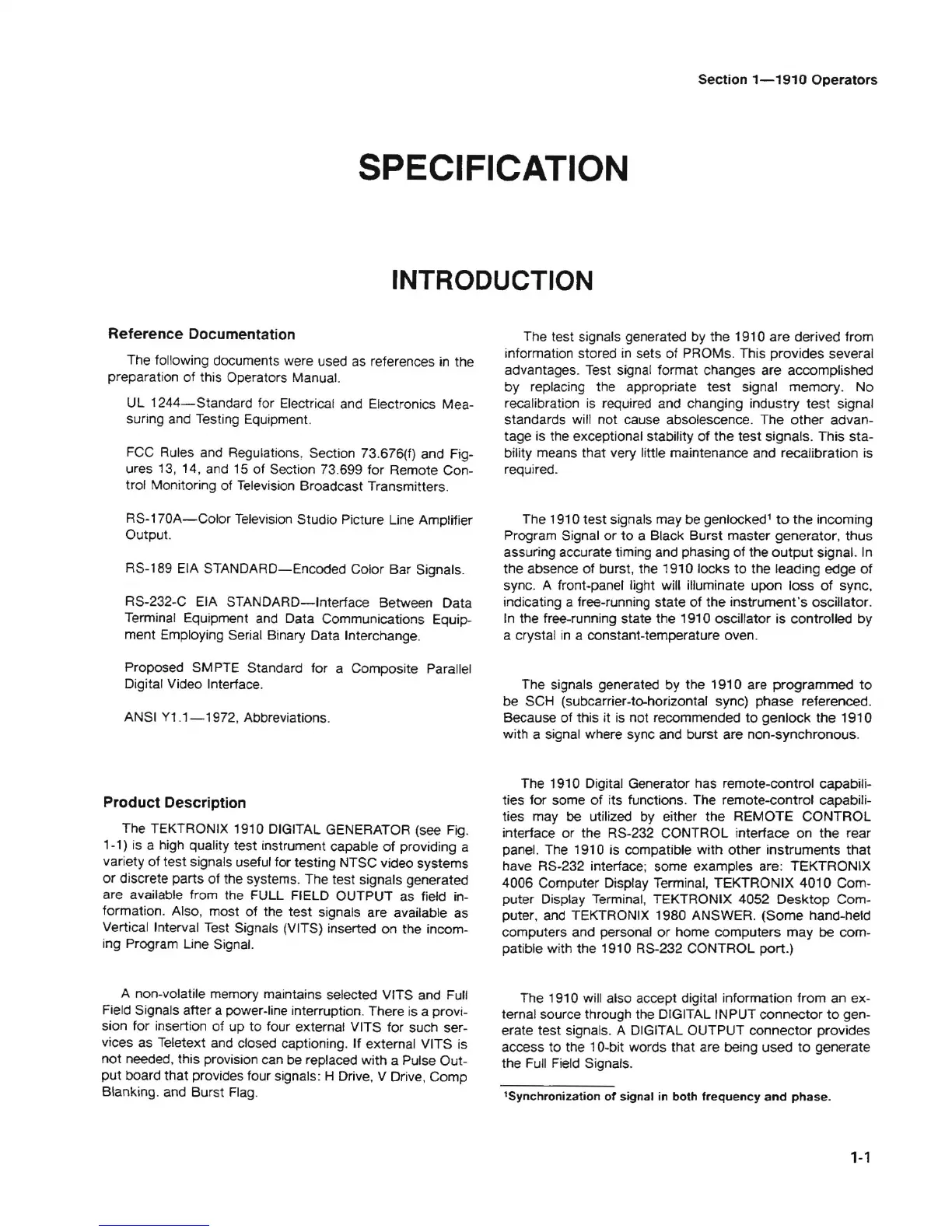Section
1-1910
Operators
SPECIFICATION
INTRODUCTION
Reference
Documentation
The following documents were used
as
references
in
the
preparation of this Operators Manual.
UL
1244-Standard
for Electrical and Electronics Mea-
suring and Testing Equipment.
FCC Rules and Regulations, Section 73,676(f) and Fig-
ures 13, 14, and 15 of Section 73.699 for Remote Con-
trol Monitoring of Television Broadcast Transmitters.
RS-170A-Color
Television Studio Picture Line Amplifier
Output.
RS-189 EIA
STANDARD-Encoded
Color Bar Signals.
RS-232-C EIA
STANDARD-Interface
Between Data
Terminal Equipment and Data Communications Equip-
ment Employing Serial Binary Data Interchange.
Proposed SM
PTE
Standard for a Composite Parallel
Digital Video Interface.
ANSI
Yl.1-1972,
Abbreviations.
Product
Description
The TEKTRONIX 1910 DIGITAL GENERATOR (see Fig.
1-1) is a high quality test instrument capable
of
providing a
variety of test signals useful for testing NTSC video systems
or
discrete parts
of
the systems. The test signals generated
are available from the FULL FIELD OUTPUT
as
field in-
formation. Also, most of the test signals are available as
Vertical Interval Test Signals
(V
ITS) inserted on the incom-
ing Program Line Signal.
A non-volatile memory maintains selected VITS and Full
Field Signals after a power-line interruption. There is a provi-
sion for insertion of up to four external VITS for such ser-
vices as Teletext and closed captioning. If external VITS is
not needed, this provision can
be
replaced with a Pulse Out-
put board that provides four signals: H Drive, V Drive, Comp
Blanking. and Burst Flag.
The test signals generated by the 1910
are
derived from
information stored
in
sets of PROMs. This provides several
advantages. Test signal format changes are accomplished
by replacing the appropriate test signal memory. No
recalibration
is
required and changing industry test signal
standards will not cause absolescence. The other advan-
tage is the exceptional stability
of
the test signals. This sta-
bility means that very little maintenance and recalibration is
required.
The 1910 test signals may be genlocked
1
to
the incoming
Program Signal
or
to
a Black Burst master generator, thus
assuring accurate timing and phasing of the
output
signal. In
the absence
of
burst, the 1910 locks to the leading edge
of
sync. A front.panel light will illuminate upon loss
of
sync,
indicating a free-running state
of
the instrument's oscillator.
In the free-running state the 1910 oscillator is controlled by
a crystal
in
a constant-temperature oven.
The signals generated by the
191
0 are programmed
to
be SCH (subcarrier-to-horizontal sync) phase referenced.
Because
of
this it is not recommended to genlock the 1910
with a signal where sync and burst are non-synchronous.
The 1910 Digital Generator has remote-control capabili-
ties for some
of
its functions. The remote-control capabili-
ties may be utilized by either the REMOTE CONTROL
interface
or
the RS-232 CONTROL interface on the rear
panel. The 1910 is compatible with other instruments that
have RS-232 interface; some examples are: TEKTRONIX
4006 Computer Display Terminal, TEKTRONIX 4010 Com-
puter Display Terminal, TEKTRONIX 4052 Desktop Com-
puter,
and
TEKTRONIX 1980 ANSWER. (Some hand-held
computers and personal
or
home computers may
be
com-
patible with the 1910 RS-232 CONTROL port.)
The 1910 will also accept digital information from an ex-
ternal source through the DIGITAL INPUT connector
to
gen-
erate test signals. A DIGITAL OUTPUT connector provides
access to the 1
O-bit
words that are being used
to
generate
the Full Field Signals.
1Synchronization
of
signal
in
both
frequency
and
phase.
1-1

